People who love to fly don’t fly economy.
For the past several months, my husband has pitched the idea of AirlineReporter readers likely being interested in a trip report written by a ’œnormal person’ like me. In this case, ’œnormal’ is defined as someone who doesn’t choose flights based on the aircraft model, or speak in cabin class codes (e.g. Y, J, M, F). I am not an AvGeek and I am sort of proud of it (although I still love you all).
My husband and I fly together several times a year and, when we do, I am able to piggyback off of his status and occasionally get a free upgrade to business/first for domestic flights. However, the ’œopportunity’ for me to fly long-haul economy eventually arose when I needed to fly from Seattle to Hyderabad, India for work.
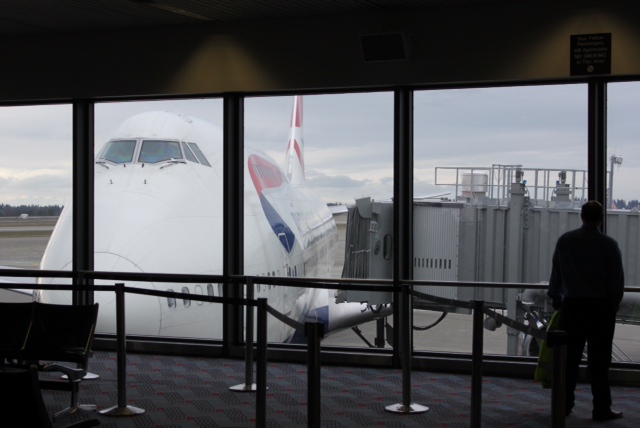
British Airways 747 seen at Seattle-Tacoma International Airport flying to London – Photo: Benjamin Whalen | AirlineReporter
To establish some context, I consider myself to be an experienced economy flier. Before meeting my husband and learning of the world of mileage runners and aviation geekdom, I had several flights between the US and Europe to visit distant relatives, as well as a semester studying abroad where I tried to fly to another city every other weekend. In all of these cases, I only ever flew economy, and have fond memories of being nestled under a blanket and binge-watching in-flight entertainment on a few good-length flights. Even though I didn’t pay much attention to the seat dimensions, I enjoyed flying and viewed it as a chance for peace, quiet, and self-reflection.
However, my flight to and from India was going to be much more rigorous than my previous travels. I had two back-to-back ten-hour flights in British Airways’ economy class, traveling from SEA>LHR>HYD. To top it off, I needed to do the reciprocal leg within five days of my arrival.
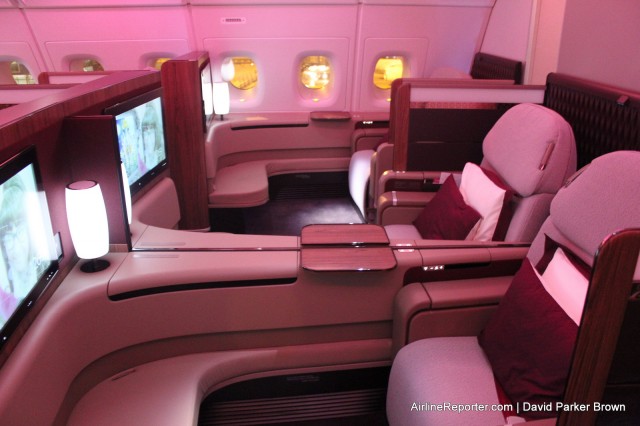
Qatar First Class product on the A380. For our flight, there were no First Class passengers.
The more that I fly the Airbus A380, the more I like the aircraft — as a passenger, but I am not so sure as an AvGeek. It is so smooth during take-off and landing, one might not even realize that they happened. Turbulence is mostly absorbed by the jumbo jet, making the flight smooth. The windows and walls are so thick, the aircraft stays quiet and passengers are removed from the flying experience.
As an AvGeek, these are some of the reasons why I am not a huge fan of the A380. I want to feel the take-off, I enjoy a little turbulence, and I want to stay connected to the entire flight experience. But this doesn’t mean I cannot enjoy an A380 flight, especially when it is on a Qatar Airways aircraft with an impressive on-board product.
Recently, I was invited to participate in the inaugural Qatar A380 flight from Bangkok to Doha, and who am I to refuse? Overall, it was an amazing flight, but I wished it was a bit longer — it was only about six hours.
One of the biggest disappointments I had regarding the flight was not being able to get an exterior shot of the A380. And believe it or not, that was partially due to both Bangkok and Doha airports being designed where photos are hard to get, and also because of the King of Thailand.
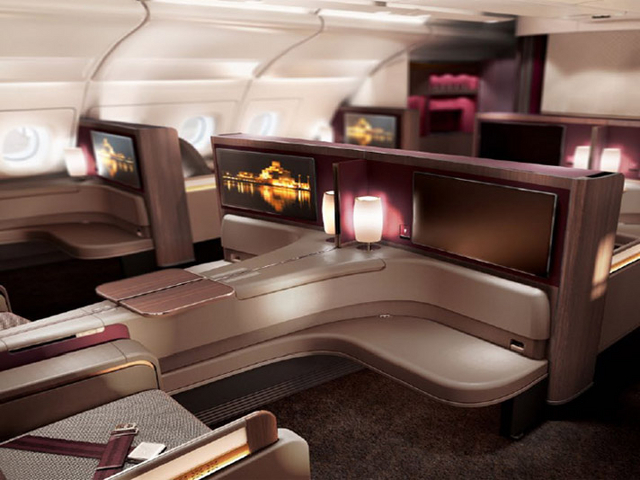
The premium cabin of Qatar’s Airbus A380 is quite impressive – Photo: David Flynn | Australian Business Traveller
Our friend David Flynn with Australian Business Traveller recently had the opportunity to check out Qatar’s impressive Airbus A380 product. Here is an snippet with a link to the full story on ABT.
Step inside Qatar Airways’ Airbus A380 for a look at the Gulf carrier’s new first class and business class cabin, the inflight bar and even the bathrooms.
Qatar’s first A380 will begin flights to London and Paris in October, but Australian Business Traveller enjoyed a first-hand look of the Gulf carrier’s superjumbo during its official delivery from Airbus.
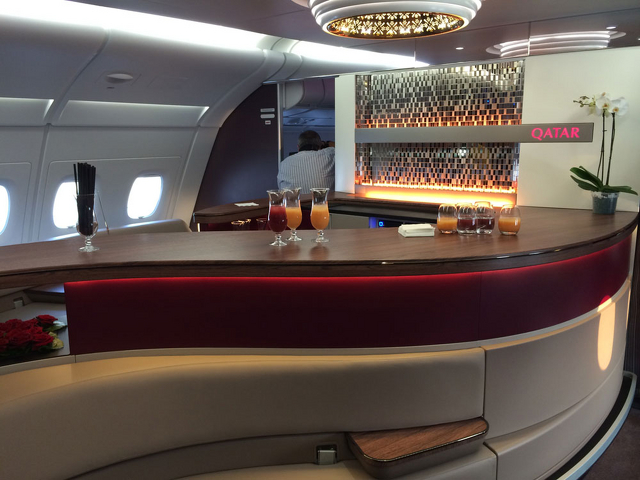
The premium lounge on the upper deck of the Qatar Airbus A380 – Photo: David Flynn – Australian Business Traveller
The configuration is relatively standard: first class, business class and a lounge/bar on the top deck, along with a small economy cabin to the very rear, while the entire lower deck is given over to economy.
Read More and See MANY More Photos of the Qatar Airlines’ Airbus A380 on Australian Business Traveller
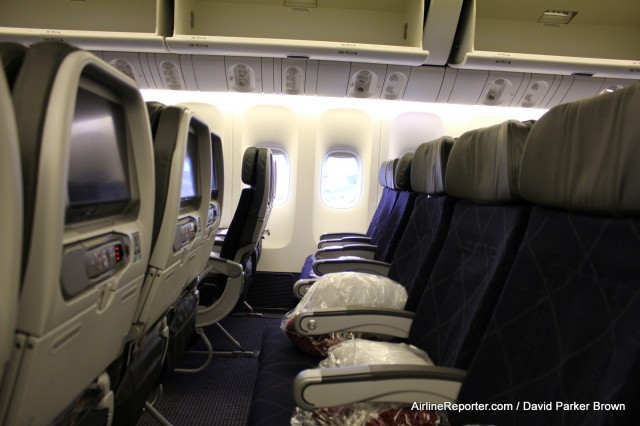
There is not a lot of room in economy to begin with, and reclining makes it worse
I am a non-recliner and I am not afraid to admit it.
What does that mean? It means that when I am flying economy (and sometimes in domestic first or a similar product), I just do not recline my seat – by choice.
I get that we are all given the “right” to recline our seats (otherwise, they wouldn’t put the button there, right?), but part of me just feels it is rude – so I don’t do it. I feel guilty every time I try to recline and wonder what I am doing to the passenger behind me. Am I smashing their laptop? Am I going to knock over a drink? Or am I going to make them roll their eyes and sigh?
Am I crazy here, or are there other non-recliners out there?
![Photo and Press Release from Boeing... SEATTLE, Feb. 11, 2014 /PRNewswire/ -- Boeing's [NYSE: BA] passenger-inspired 737 Boeing Sky Interior marked its 1,000th milestone delivery with Norwegian Air Shuttle ASA. The 737 Boeing Sky Interior features modern sculpted sidewalls and window reveals, LED lighting that enhances the sense of spaciousness and larger pivoting overhead stowage bins. "The Boeing Sky Interior is delighting passengers and our airline customers," said Beverly Wyse, vice president and general manager, 737 program, Boeing Commercial Airplanes. "It's adding even more value to the Next-Generation 737, which already delivers the best economics, reliability and fuel efficiency in its class." Norwegian Air Shuttle was one of the launch customers for the 737 Boeing Sky Interior. This is the airline's 48th Next-Generation 737-800 with the new interior, making it the largest airline operating with the 737 Boeing Sky Interior in Europe. "Our goal is to provide passengers with the ultimate experience in comfort and convenience when they fly with Norwegian," said Bjorn Kjos, chief executive officer of Norwegian Air Shuttle. "The Boeing Sky Interior on the Next-Generation 737 helps us to deliver just that." A passenger survey conducted by Norwegian Air Shuttle soon after the airline began service with the new look found that more than half of respondents rate the 737 Boeing Sky Interior more comfortable than the standard interior. And passengers reported they feel "happier" in the new interior. Since the first 737 Boeing Sky Interior was delivered in October 2010, more than 60 customers have ordered the new interior. Approximately 85 percent of Boeing's backlog of more than 1,900 Next-Generation 737s will be delivered with the 737 Boeing Sky Interior. The passenger-preferred interior will be standard on Boeing's newest family of single-aisle airplanes, the 737 MAX.](https://www.airlinereporter.com/wp-content/uploads/2014/02/Norwegian_BSI-640x427.jpg)
Norwegian Air Shuttle economy class on a Boeing 737 – Photo: Boeing
It makes sense. Do not get me wrong, this is true – but even then I knew it was a gross over-complication. It only really made sense in the premium cabin, where passengers made their airline selection on a factor other than pricing. Airlines don’t actually deal in seats; a seat is kind of a nebulous thing that cannot be quantified easily.
Airlines deal in unit cost and unit revenue. You’ve all probably heard the term CASM (Cost per available seat mile) thrown around, same with RASM (Revenue per available seat mile). Well, when you buy a seat, you are buying capacity on the flight at a specific fare.
It gets worse, because the available seat mile is extremely perishable. It’s gone, forever, once you close the door. There are a good deal of complex price discrimination strategies employed by airlines to ensure that their customers never pay less than they ought to – but before I hurt your heads with complex math and graphs, allow me to completely change the tone of my argument.
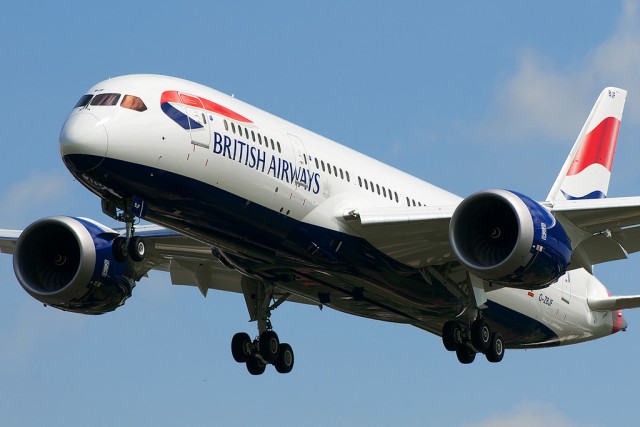






![Photo and Press Release from Boeing... SEATTLE, Feb. 11, 2014 /PRNewswire/ -- Boeing's [NYSE: BA] passenger-inspired 737 Boeing Sky Interior marked its 1,000th milestone delivery with Norwegian Air Shuttle ASA. The 737 Boeing Sky Interior features modern sculpted sidewalls and window reveals, LED lighting that enhances the sense of spaciousness and larger pivoting overhead stowage bins. "The Boeing Sky Interior is delighting passengers and our airline customers," said Beverly Wyse, vice president and general manager, 737 program, Boeing Commercial Airplanes. "It's adding even more value to the Next-Generation 737, which already delivers the best economics, reliability and fuel efficiency in its class." Norwegian Air Shuttle was one of the launch customers for the 737 Boeing Sky Interior. This is the airline's 48th Next-Generation 737-800 with the new interior, making it the largest airline operating with the 737 Boeing Sky Interior in Europe. "Our goal is to provide passengers with the ultimate experience in comfort and convenience when they fly with Norwegian," said Bjorn Kjos, chief executive officer of Norwegian Air Shuttle. "The Boeing Sky Interior on the Next-Generation 737 helps us to deliver just that." A passenger survey conducted by Norwegian Air Shuttle soon after the airline began service with the new look found that more than half of respondents rate the 737 Boeing Sky Interior more comfortable than the standard interior. And passengers reported they feel "happier" in the new interior. Since the first 737 Boeing Sky Interior was delivered in October 2010, more than 60 customers have ordered the new interior. Approximately 85 percent of Boeing's backlog of more than 1,900 Next-Generation 737s will be delivered with the 737 Boeing Sky Interior. The passenger-preferred interior will be standard on Boeing's newest family of single-aisle airplanes, the 737 MAX.](https://www.airlinereporter.com/wp-content/uploads/2014/02/Norwegian_BSI-640x427.jpg)